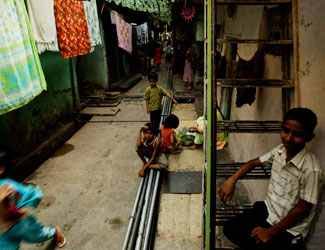Some see hope for change as the film, with four Golden Globe awards and 10 Oscar nominations, spotlights the desperation of slum life.
By Anuj Chopra

MUMBAI, INDIA – John D’souza hasn’t yet seen the much-feted film “Slumdog Millionaire.” But he is convinced the film has the power to transform his life.
Mr. D’souza, a social worker who has lived all his life in Dharavi, a grubby slum in Mumbai (Bombay) that is touted as Asia’s largest, believes that this film can highlight the invisible lives of slum dwellers and create awareness about their abominable living conditions.
“The film has put Dharavi on the world map,” says D’souza, whose shanty has a cameo in the film. “Hopefully, it will help people and [the Indian] government understand that we, too, deserve a dignified existence.”
Directed by the British director Danny Boyle and based on Indian diplomat Vikas Swarup’s novel, “Q&A,” Slumdog Millionaire has already won four Golden Globe awards and this week garnered 10 Oscar nominations, including one for best film. Set in the fetid alleyways of Mumbai’s teeming slums, Slumdog is a Dickensian tale of an orphan who ingeniously cuts away from his wretched existence to become a champion on the TV game show, “Who Wants to Be a Millionaire.”
Even before its Friday release in India, the film’s riveting international success had sparked celebrations – and generated hopes in some quarters of its potential to impact change.
“Slumdog … is Boyle’s gift to Mumbai,” Shobha De, a socialite and author, wrote in the Times of India, earlier this month.
“Whether or not Boyle’s film wins an Oscar or two is immaterial,” Ms. De wrote, unabashedly admitting she had watched the film on a pirated CD. “It should be made compulsory viewing for anybody who wants to understand the shocking, ghastly subtext that deals with the ‘other’ Mumbai – the one that feeds on abject poverty and paradoxically enough, also on the soaring hope that this same poverty breeds success.”
Many observers draw parallels of the film with “Salaam Bombay,” a 1998 film by internationally acclaimed filmmaker Mira Nair, which encapsulated the despair and desperation of Mumbai’s street kids. Eventually, Ms. Nair set up the “Salaam Bombay Foundation,” a charity dedicated to them. Her moving portrayal of street kids helped generate awareness and funds to improve their plight.
Some social workers and nongovernmental organizations hope that “Slumdog Millionaire” will do similar good for slum dwellers.
More than 60 percent of Mumbai’s citizens are known to reside in slums. The most visible of them is Dharavi, a labyrinth that is home to more than 1 million people. A majority of them are migrants, and all of them – 17,000 stuffed into each acre – are scrambling for space in a sea of weathered iron shacks and mildewed tenements.
Cholera and other waterborne diseases are endemic in Dharavi. Sanitation facilities are scarce, with one toilet for every 1,500 people, according to the World Bank. Drinking water is in short supply; families of 15 share one water tap.
Many of Mumbai’s elite view Dharavi as a blight that must be purged if the city, India’s financial and entertainment capital, is to achieve stature as a world-class city. Local politicians have long dreamed of transforming Mumbai into “India’s Shanghai.”
Sheela Patel, the director of the Society for the Promotion of Area Resource Centers, a nongovernmental organization that works with slumdwellers, is intrigued by the success of “Slumdog Millionaire,” but skeptical that it will prompt lasting change.
“Having seen well-made films in poverty from Brazil and South Africa, I believe that like all events on the screen, the film will throw a spotlight on slum life and poverty,” she says. “But such focus moves on as new events and news replace yesterday’s focus.”
The film has also spawned concerns the film, which starkly portrays India’s epic poverty, will tarnish the international reputation of the country, well known in recent years for its torrid economic boom. Some critics have derisively labeled it as “poverty porn.”
About two dozen slumdwellers on Thursday demonstrated outside the Mumbai home of Anil Kapoor, one of the film’s stars, outraged by the insulting title of the movie.
The Times of India, however, called the film “a piece of riveting cinema,” urging moviegoers to forget “the twitter about aggrieved national sentiment.”
Jubilant about the Oscar nominations – a rarity for films dealing with India – the national daily called the film “a Cinderella-like fairy tale with the edge of a thriller and the vision of an artist.”
Courtesy: csmonitor.com

